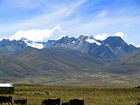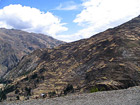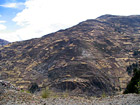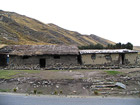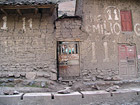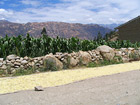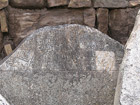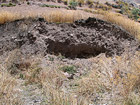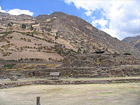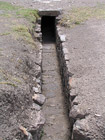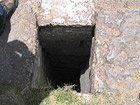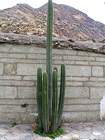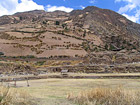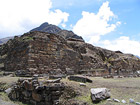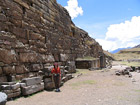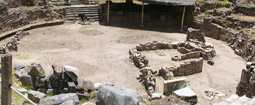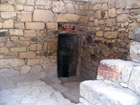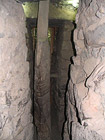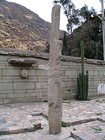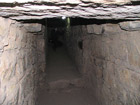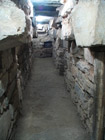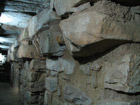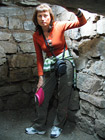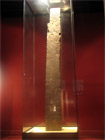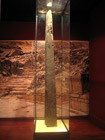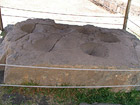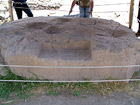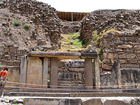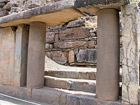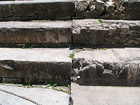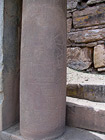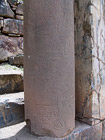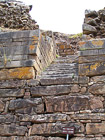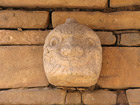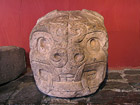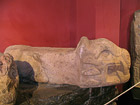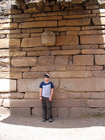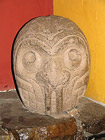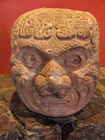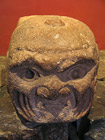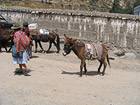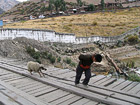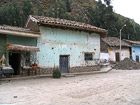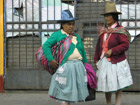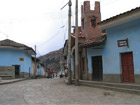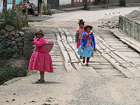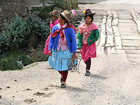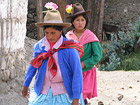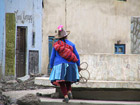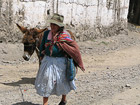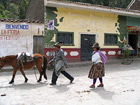|
Chavin culture – mysteries remain
| |
Irina Nazarova, Peru
January, 2007.
|
|
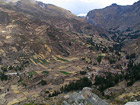 |
The village Chavin de Huantar is situated to the north of Lima, in the heart of the Andes at the height of 3180 meters. Here, in the valley of river Mosna, feeder of Marañon, archaeologists revealed the traces of another ancient culture that was named after the name of the village - Chavin.
Till now, near the ancient ruins there are shabby houses of local peasants, for whom the archaeologists simply cannot find the place to move in. In 1840 an Italian geographer and enthusiast of history Antonio Raimondi by sheer luck turned out to be the guest of a local resident Timoteo Espinosa. Raimondi was amazed to see the table top in the house to be a stone plate with the image of a divine being. It was an ancient stela. The Italian immediately realised the value of his discovery. Thanks to his efforts, the stela was «saved» and sent to Lima. In 1874 the «Raimondi stela» found its worthy place at the National museum of archaeology, anthropology and history of Peru.
The stela was the first valuable discovery in Chavin, that made the archaeologists look closely to that region. Julio Cesar Tello, father of the Peruvian archaeology, started the works in Chavin in 1919. He was not the first researcher of that territory, but he was the first to express the thought about the significance of Chavin culture in the history of civilisations in Peru.
As scientists assume, Chavin was an important ceremonial center. Roads from all corners of Peru used to lead there – from coastal plains, from mountainous settlements, from selva. The complex dates back approximately to 1000-1200 B.C. Chavin might have been inhabited even before that time, but the first findings of the pieces of art in Chavin style belong exactly to that period. Approximately in 800 B.C. in the period of the maximum flourishing and influence, its own «restructuring» started in Chavin, and old structures turned out to be covered by new temples, that made the study of the past of that civilisation even more complicated.
The origin of the Chavin culture itself, and rather its bearers till now remains a mystery. Julio Cesar Tello thinks that the roots of Chavin should be looked for in selva, it was from there that future Chavinians emerged. This, at first glance, can be easily proved by art and religion: the Chavinians worshiped animals living in selva – jaguar, cayman, snake. These mighty, independent creatures embodied strength and power for them. It was these tropical animals and plants that were the main elements in architecture and art. However, the most vulnerable point in this theory was that no traces of any developed culture that could give an impetus for developing of Chavin, to be its «ancestral home» was ever found in selva.
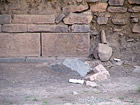 |
The singularity of Chavin is that like Caral, the influence of which is clearly seen in its culture, it managed to exist almost a thousand years without wars and conflicts with neighbours. Similarly to Caral, no fortifications or weapons were found there. They think that Chavin was a sacred place that did not need the defence. And glory of Chavin outlived its physical existence by more than 2 thousand years.
When in the XIVth century a monk Fray Antonio Vasquez de Espinoza came to that place, local residents told him that pilgrims from the remotest places of Peru used to come to Chavin. As it was noted by the monk, that place was as significant for them as Rome or Jerusalem for Christians. Pilgrims used to perform some ritual actions and made offerings to their gods. And in the period of flourishing of Chavin, offerings would come from such distant places like modern cities of Peru - Trujillo, Cajamarca, Lima, Huanuco, Paracas. And in its turn, the handmade goods from Chavin – ceramics, fabric, golden items – were found hundred kilometers away from it. Chavin was, if one can say like that, in fashion on the vast territory of Peru, where traces of its style in architecture and art were found.
In the III-IVth century B.C. due to some unknown reasons Chavin ceased to be a ceremonial centre (maybe some crisis of ancient religion took place) and in the beginning of our era local peasants started to settle down on top of the previously majestic ruins.
The complex started to go to ruins very quickly and was sinking into oblivion. But not only man, but the nature itself «took a hand in» destruction of Chavin. Between 1925 and 1933 heavy rains regularly provoked powerful floods of the Mosna river that partially flooded Chavin, and on January 17, 1945 heavy rains caused the most devastating mud flow, which practically completely covered the ceremonial centre and a part of the village by a layer of several meters high. And the archaeologists had to begin everything from the very beginning. Alas, certain portion of the previously found items was irretrievably lost.
Archaeological excavations enabled to restore some details of the life of ancient Chavin. As long as it was a religious centre, sacrificers, naturally, were its main characters, who used all means of influence on psychic. Sessions of hypnotism where hundreds of people participated were regularly held at the central Square Plaza. Charming dances under the accompaniment of majestic sounds of huge seashells, incomprehensible noise of water from the underground canals, all this served the sacrificers.
Canals, more than 3 km long, were the height of engineer art of the Chavinians, they were laid even under the underground tunnels. Canals served the two purposes: practical – as drainage, overflow system (it was especially important for deep areas) and ritual – for psychologic influence on the audience that did not understand the origin of the powerful sound and conceived it as something supernatural.
Canals used to have ventilating shafts – both for direct ventilating and to hear better the noise of running water. It is possible that sacrificers would direct the roaring stream of water to the canals only during the ceremonies so that to cause an unexpected acoustic effect. Nowadays these canals are dry, but the physical experiment proved that the sound of water in the tunnels resembled the roar of a lion.
While performing the ritual, sacrificers used different hallucinogens. The hieratic plant is cactus San Pedro, the image of which, including in the hand of a sacrificer – is a widespread subject in the Chavin art. Cactus San Pedro contains mescaline – alkaloid that causes optical and acoustic hallucinations. With its help the sacrificers would fall into a trance, transforming into a totem animal – jaguar, condor, snake, cayman, and when believed, it helped the sacrificers to contact the higher powers, learn the mysteries of being and possibly to influence the current of events. This process is described in the Chavin art in detail. During excavations they found small delicate pipes made of birds' bones, which, according to archaeologists, were used to inhale drugs through the nose.
The name of the cactus «San Pedro» is clearly a new one, derives from catholic monks. And it is very symbolic, as apostle Peter had the keys from Heaven, so is the cactus was the key to the kingdom of heaven. Therefore the monks obviously experienced the effect of the cactus from ancient frescos. B the way, at the north of Peru - in Trujillo, Chiclayo – till now you can find curanderos (healers) that use cactus San Pedro for their patients. Seeds of different tropical plants containing alkaloids were also used as hallucinogens.
Those sacrificers were excellent astrologers and watching the celestial bodies could predict the changes in climate, draughts and floods. Combining celestial observations and knowledge of animals habits and other signs of nature, they were successful in making the calendar of agricultural works and it increased their authority among the people.
Initially the Ancient Temple (Templo Antiguo) was the ceremonial core with its Circular Plaza (Plaza Circular) and later – the New Temple (Templo Nuevo ) with its Square Plaza (Plaza Cuadrangular). It is difficult to say how the Ancient Temple looked like before restructuring, but the underground galleries underneath remained in perfect condition and are, probably, the most spectacular portion of the modern complex.
Tunnels of Chavin also produce impression. Their total length is about 3 kilometers. Some tunnels served for ritual purposes (like Galeria del Lanzon), others were meant to keep the offerings to gods (like Galeria de las Ofrendas).
But of course, the most famous gallery is the one where the symbol of the most ancient and important deity of Chavin - Lanzon (spear) is stored. It is called like this because in its shape it resembles this weapon. Lanzon is situated in the centre of cross-shaped intersection of underground galleries under the Ancient Temple. It is made of white granite, is four and a half meters high and embedded in the ground that could symbolise fertility. Some anthropomorphous creature with unusual features is depicted on the obelisk and it fills with fear and demands obedience: big fangs, claws on hands and feet, hair and brows in shape of live snakes. Headwear and belt also consist of snake and jaguars heads. The deity on Lanzon looks at the east where a new day is born. But presumably only twice a year – in spring and autumnal equinox – the sun ray completely illuminates the deity from the opening right above it. Rest of the year the light practically did not penetrate that room.
It is interesting but the galleries were not illuminated by anything. Unlike all other underground structures on the planet, here they did not find any traces of torch soot or anything like that. It also might be the means for «brainwashing» during the ceremonies. When a drugged newcomer, was blindly taken along the dark underground tunnels under the accompaniment of obscure sounds of running water, meeting with the main deity Lanzon, unexpectedly illuminated by a single ray of light from the top, should act as a lightening bolt. In the tunnels there are small rooms (2x2 m) where the initiation or psychologic preparation of sacrificers to rituals might have taken place.
In the centre of the Circular Plaza they found the so called «Tello obelisk». Most likely it was not a simple image of a deity, but the distinctive «bible» that could only be read by religious ministers of Chavin. The myth of origin of the world might have been depicted on the obelisk, where you can see practically all plants and living creatures from selva. The picture is very complicated, it contains 72 different figures. The figure arranged in the centre arouses most of the questions. Usually it is called a cayman (rather a dragon with the head of a cayman and tail of a fish), but certain specialists according to some features determined that it was the head of a crocodile. So, cayman or a crocodile? Why is it important? The fact is that caymans live on the territory of Peru, but crocodiles out of the complete territory of the Latin America are only met in Ecuador, so consequently, if we consider the image a head of a crocodile, then origin of the Chavin culture can be looked for even there. The two and a half meter high monolith, located in the middle of the Circular Plaza could also act as a sundial. It is curious, but the main figure on one side of the obelisk is male whereas on the other side – female. Similarly to the «Raimondi stela» the original of the «Tello obelisk» is kept in the National museum of Peru.
In the later period the most significant and important structure was a New Temple, known under the name of El Castillo (the Castle). In front of the New Temple there is a Square Plaza where public ceremonies were held.
It is known that the sacred number for the Chavinians was 7 that local guides sometimes speculate about. For example, the size of the Square Plaza is 49 x 49 m. 49 is 7 squared, and guides try to impress tourists with it. But it has absolutely no meaning, as 3 thousand years ago there were different units for measuring the length.
Both the Square and Circular Plazas are deepened and that shows the influence of Caral.
There is an Altar near the Square Plaza. It is a monolith, on the surface of which there are 7 hollowed out recessions. It is called an Orion as the location of recessions matches the location of stars in the Orion constellation, but if you look from the other side, your imagination may prompt you to see the contours of a jaguar. One thing is evident, that Altar was used by the religious ministers for some calculations, watching the stars and, maybe, eclipse of the Sun, as filled with water, these recessions excellently reflect all celestial bodies and phenomena.
Another preserved detail of the New Temple is a Portico (colonnade) of Birds of Prey. The columns depict mythical anthropomorphous birds, on one of them – with male features, on another one - with female. On the upper portion of the colonnade there are 7 birds, where the northern column supports the block made of black stone, and the southern one – of white. In other words here two basic tendencies are preserved – dualism and a sacred number 7.
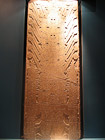 |
The above mentioned «Raimondi stela» is a rose colour monolith of 198 cm long and 74 cm wide. One side is smooth, on the other there is a deity - an anthropomorphous figure, in each hand keeping a mace, with separate features of jaguar (claws, nose, fangs). The «headwear» of the deity consists of 4 zoomorphic characters. This, so called «god with maces» is a very ancient figure and popular in the Andes and coastal cultures. For example, a lot of images of this deity was found in Paracas. It is possible that the «god with maces» is more ancient than the Chavin culture.
There were very unusual stone heads on the outer wall of the complex at the height of 12 m (39.37 feet). Unfortunately only one of them remained at its place, but in the storage you can see more than a dozen of these heads. All of them bear the zoomorphic features. The one on the wall is a half-man-half-jaguar; there are heads with features of birds, etc. There are also very strange heads – with secretions from nose. It is thought that they depict different stages of transformations after using the drugs: from the phase of nausea, bleeding from the nose that can be the result of sniffing the powder, to complete transformation into a totem animal. These heads might have been the original keepers of temples, but there is another hypothesis which will be described below.
As a whole, the structures were quite complicated, with a number of multi-layer platforms and grounds, terraces and galleries, staircases and colonnades, made of blocks of various rocks, brought to the city from different places. For example, white granite, famous among the Chavinians, can only be found at the distance of several dozens kilometers. All structures were decorated by numerous bas-reliefs, stelas, sculptures of gods. Everything was also oriented according to the corners of the earth, depending upon their designation.
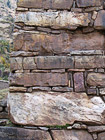 |
Chavin structures are aseismic that was achieved by special masonwork – one layer of big blocks alternated with two layers of flat stones.
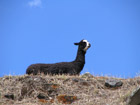 |
I cannot help but mention another unexpected hypothesis that Chavinians practised cannibalism. In the Gallery of sacrifices along with the remains of eaten deer, llamas, birds they also found some remains of human bodies of different age that were cut, boiled or fried, in the same manner as parts of animals.
Of course there is no direct evidence of cannibalism, but it is known that in that epoch it was quite a widespread phenomenon. Followers of this hypothesis found the confirmation in heads on the wall. We know the practice that heads of the defeated enemies or on the contrary, of very respected members of the society, but with totally opposite purposes, were put out for general observation. And the stone heads are allegedly the proof of such a practice in Chavin.
As a whole cannibalism totally disappears in Peru since the Vth century A.D., but the practice of demonstrating the heads of killed enemies or deceased relatives remained till the Xth century.
Another mystery of Chavin – total absence (as in Caral too) of burial grounds of that period. There are even no hypotheses on that matter.
One of the main problems of archaeology in Peru – is its scanty financing, that is hardly enough for excavations. Other countries often render financial and intellectual assistance. Thus, in Chavin the majority of excavations was done by archaeologists from Stanford university, and recently, Japan donated 2.5 millions dollars for construction of National museum of Chavin, where findings of this culture will be collected.
Although it may not be ethical to speak about shortage of money for archaeology in the country, where the majority of the population lives in terrible poverty. That village Chavin de Huantar strikes with poverty. All the population speaks quechua, practically all females, starting from girls to elderly women, wear national dresses. But certainly not the bright-carnival ones as usually shown in films, but old, worn dresses and obligatory traditional hats. And it is a pity that the country with so rich past cannot provide decent present to its residents.
|



